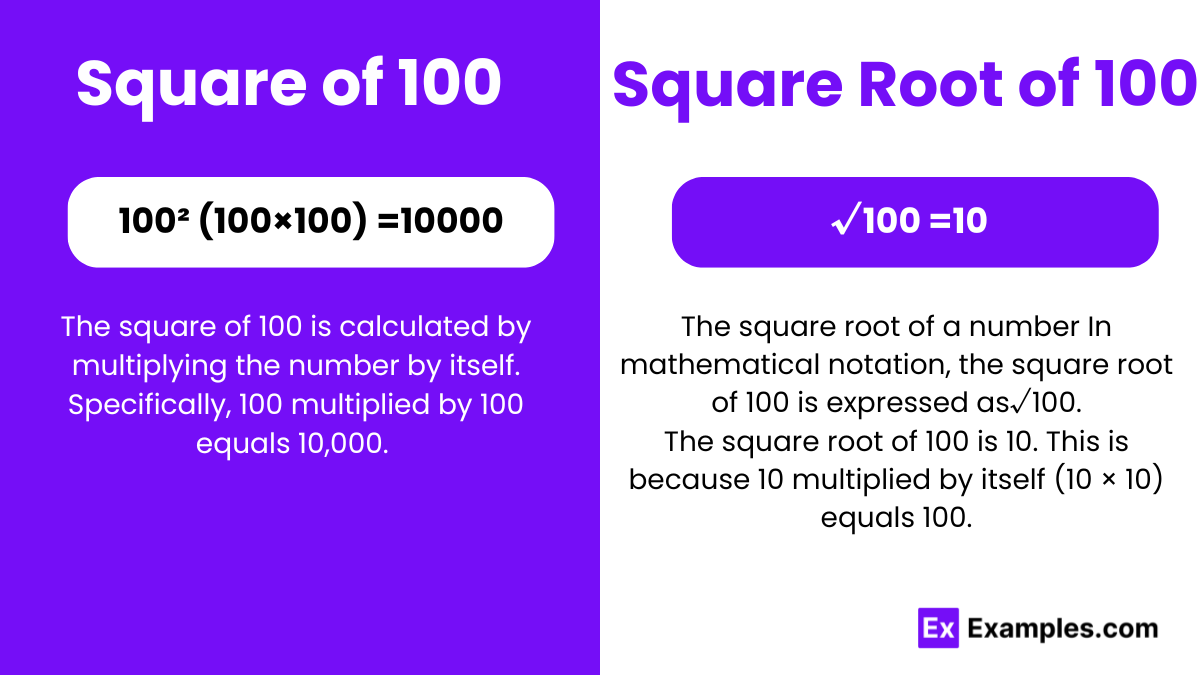What is the square of 100?
10,000
1,000
1,00
1,000,000

The square number of 100 is calculated by multiplying the number by itself. Specifically, 100 multiplied by 100 equals 10,000. This operation is fundamental in mathematics, especially in algebra.
The square root of a number In mathematical notation, the square root of 100 is expressed as
√100.
The square root of 100 is 10. This is because 10 multiplied by itself (10 × 10) equals 100. Mathematically, the concept of a square root arises from the function f(x)=x ² , where finding the square root of a number means determining the non-negative value x such that f(x)=100.
Square Root of 100: 10
Exponential Form: 100^1/2 or 100^0.5
Radical Form: √100
This is because it can be expressed as an exact fraction. Specifically, the square root of 100 is 10, which can be expressed as the fraction 10/1. In general, a number is considered rational if it can be expressed as a fraction where both the numerator and the denominator are integers (and the denominator is not zero).
rational numbers As you mentioned, rational numbers are numbers that can be expressed as a fraction where both the numerator and the denominator are integers, and the denominator is not zero. This includes
Example:1/2,3/4
Irrational numbers, on the other hand, cannot be expressed as a ratio of two integers. Their decimal expansions are infinite and non-repeating. These numbers often arise in geometry and algebra, especially involving roots of numbers that are not perfect squares or certain ratios like the circumference to the diameter of a circle (π).
Example:√2,√3
This method involves guessing numbers that might be the square root and then squaring them to see if the result is 100. For example:
This involves breaking down the number into its prime factors:
Simply using a scientific calculator, you can find the square root function (often denoted as ) and input 100 to get the result.
This is a traditional approach similar to long division:
Using properties of logarithms or exponents:

Step 1: Pair the digits from right to left.
For the number 100, pair the digits as 1 and 00, with a bar over them to indicate the pairing.
Step 2: Find the largest number whose square is less than or equal to the first pair.
For the first pair (1), the largest number whose square is less than or equal to 1 is 1 itself (since 1×1=1). Subtract 1 from 1, which leaves a remainder of 0. Write down 1 as part of the quotient.
Step 3: Bring down the next pair of digits next to the remainder.
Bring down 00 to the remainder, making it 00. Now, double the quotient (which is currently 1) to get 2. This 2 becomes the first digit of your new divisor.
Step 4: Complete the division to find the next digit of the quotient.
Find a digit to place in the unit’s place of the new divisor (currently 20_) so that its product with the same digit is less than or equal to 00. Placing 0 in the unit’s place makes the new divisor 20. 20×0=0, which fits since it leaves a remainder of 0.
Yes, 100 is a perfect square. This means there is a whole number (in this case, 10) that can be multiplied by itself to give the number 100. Thus, 10×10=100, confirming that 100 is indeed a perfect square.
To solve √100, you can simply recognize that the number 100 is a perfect square. The square of 10 is 100, hence, √100=10.
Yes, 100 is a perfect square. A number is considered a perfect square if there is an integer that can be multiplied by itself to reach that number. In the case of 100, it is 10×10, which makes it a perfect square.
The principal square root of a number refers to the non-negative square root. For 100, the principal square root is 10. This is typically denoted as √100=10, emphasizing that it’s the positive square root.
Text prompt
Add Tone
10 Examples of Public speaking
20 Examples of Gas lighting
What is the square of 100?
10,000
1,000
1,00
1,000,000
Find the square root of 100.
5
10
15
20
What is 100 squared?
10,000
1,000
100
1,000,000
If x² = 100, what is the value of x?
10
-10
Both 10 and -10
5
What is the result of 100 raised to the power of 1/2?
10
20
30
50
What is the square of the square root of 100?
10
30
50
100
What is the square of 5 multiplied by the square root of 100?
50
25
100
125
What is the result when you subtract the square root of 100 from 100?
60
70
80
90
If 100 is a perfect square, what is its square root?
10
20
30
50
What is the square of 10?
50
100
150
200
Before you leave, take our quick quiz to enhance your learning!

